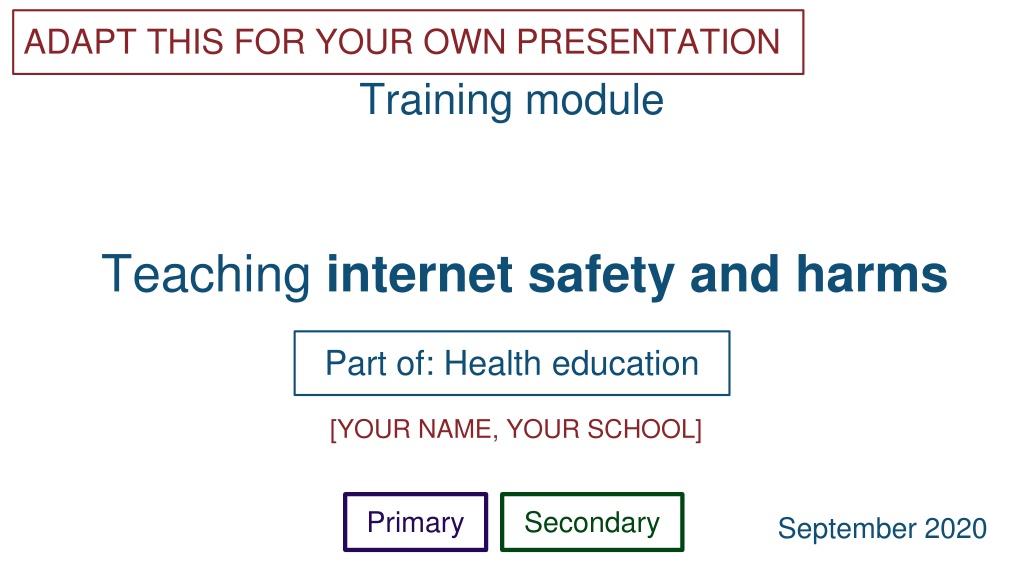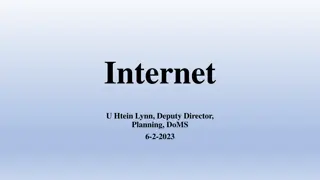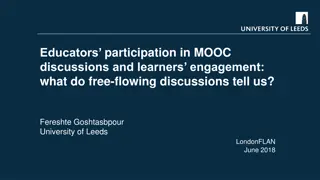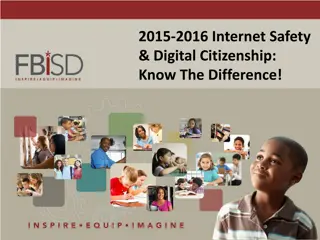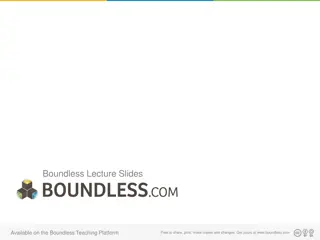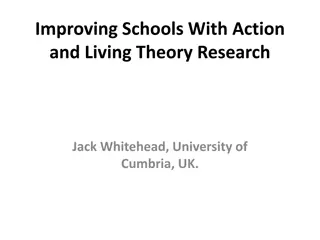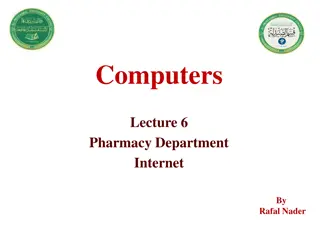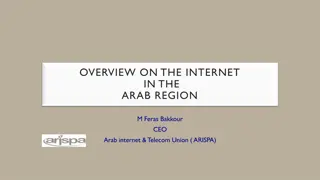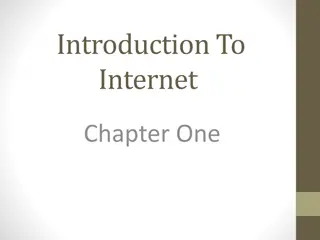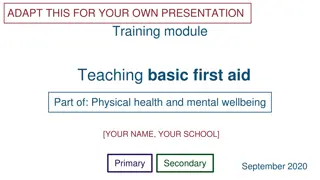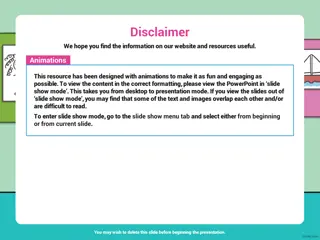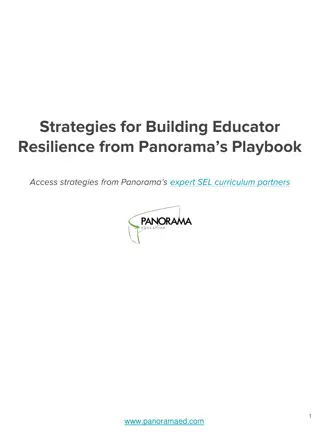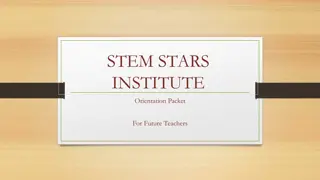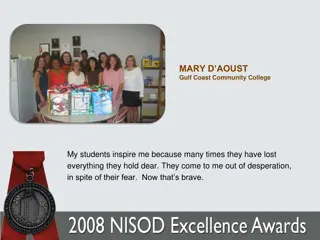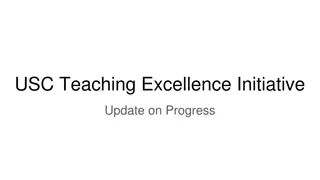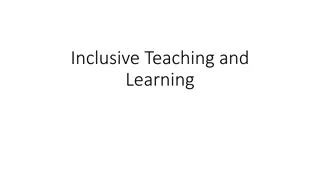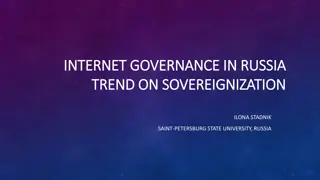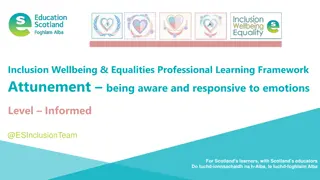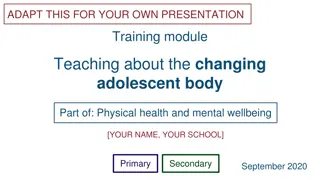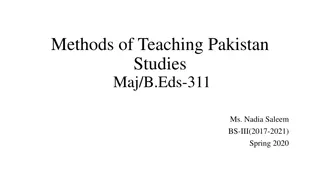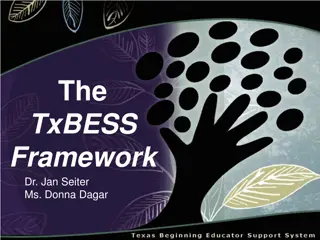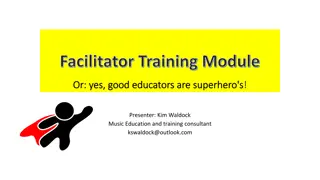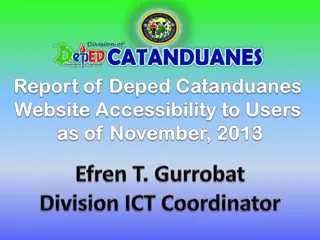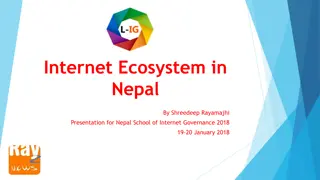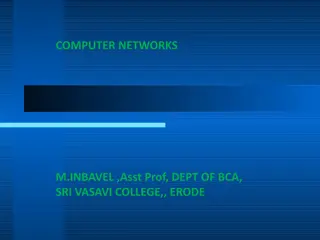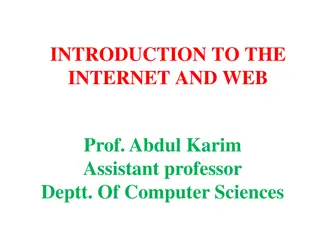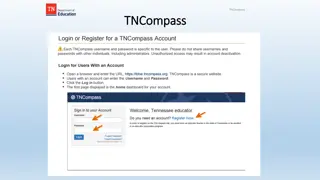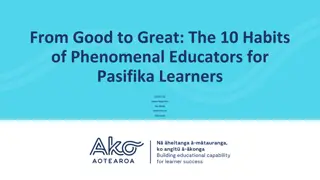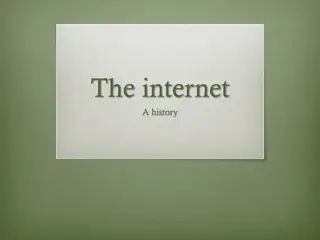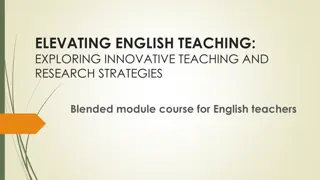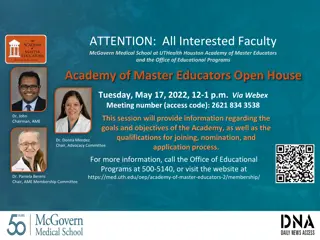Internet Safety Training for Educators: Teaching Strategies and Resources
Dive into a comprehensive training module on Internet safety and harm prevention for educators, covering the new curriculum, safeguarding measures, activities, and examples of good practice. Gain essential knowledge, strategies, and confidence to effectively teach students about online safety. Explore related topics and guidance to enhance your teaching approach for a safer online environment.
Download Presentation

Please find below an Image/Link to download the presentation.
The content on the website is provided AS IS for your information and personal use only. It may not be sold, licensed, or shared on other websites without obtaining consent from the author. Download presentation by click this link. If you encounter any issues during the download, it is possible that the publisher has removed the file from their server.
E N D
Presentation Transcript
ADAPT THIS FOR YOUR OWN PRESENTATION Training module Teaching internet safety and harms Part of: Health education [YOUR NAME, YOUR SCHOOL] Primary Secondary September 2020
Contents 3 About this training module 5 Teaching the new curriculum 15 Safeguarding 18 Ground rules 21 Primary curriculum 48 Secondary curriculum 66 Examples of good practice 73 Activities and templates for trainers 2
About this training module Subject leads can use the adaptable slides and activities and templates for trainers section at the end of this module to help shape training sessions for teachers. This non-statutory training module supplements the statutory guidance on teaching internet safety and harms, which schools should read in full. Schools can choose whether and how to follow or adapt this training module and should refer to the Early Career Framework for pedagogical guidance. 3
What you get out of today By the end of this training you should: know what is included in the statutory guidance know some key knowledge and facts to cover as part of this topic have strategies to deal with questions that come up in class feel more confident teaching about internet safety and harms 4
Related topics Internet safety and harms is closely related to the computing programmes of study as well as to: online relationships (primary), online and media (secondary) other topics such as respectful relationships, being safe and mental wellbeing Therefore you should: consider thematic links across key topics and the whole school when planning and delivering lessons find ways to link knowledge and vocabulary across topics 6
Related guidance Schools may also want to refer to the following related guidance when planning to teach this subject: Education for a connected world Teaching online safety in schools (RSHE-specific guidance) Guidance for schools on preventing and responding to bullying (including cyberbullying) Keeping children safe in education Digital resilience framework 7
Support for this topic at [school name] Our leads [Names, contact details - e.g. IT lead] Our policies [Add details - e.g. school policy on PSHE, training opportunities] Specialist support [Add details - e.g. providers school already works with] Other information [Add resources] 8
Existing teaching at [school name] Ways in which we already teach about internet safety and harms at our school: [add details] [add details] [add details] 9
Role of the internet in pupils lives From September 2020 schools must have regard to the statutory guidance for teaching about internet safety and harms. The guidance explains the significant role the internet plays in pupils lives. STATUTORY GUIDANCE Today s children and young people are growing up in an increasingly complex world and living their lives seamlessly on and offline. This presents many positive and exciting opportunities, but also challenges and risks. In this environment, children and young people need to know how to be safe and healthy. (p4) 10
Primary and secondary teaching Some slides in this training have a Primary or Secondary label to indicate that the material is usually first introduced in that phase. STATUTORY GUIDANCE Schools have flexibility to design and plan age-appropriate subject content. (p31) Using your knowledge of your pupils and school community you can: introduce secondary content in primary with pupils who need it and are ready teach the primary content in early secondary lessons to pupils who need to build knowledge before secondary content is taught 11
LGBT needs and inclusion Primary schools are enabled and encouraged to cover LGBT (lesbian, gay, bisexual and transgender) content if they consider it age appropriate to do so. Secondary schools should include LGBT content. When doing so, schools should ensure: LGBT-relevant knowledge and examples are included throughout programmes of study (not one-off teaching) inclusive language is used, considering how individual pupils may relate to particular topics 12
Pupils with SEND You will need to plan lessons to allow all pupils to access and practise the core knowledge, using your expertise as you normally would. You might want to link lesson outcomes with statutory preparing for adulthood outcomes for those with an education, health and care (EHC) plan. (See SEND code of practice, section 8.) STATUTORY GUIDANCE In special schools and for some SEND pupils in mainstream schools there may be a need to tailor content and teaching to meet the specific needs of pupils at different developmental stages. As with all teaching for these subjects, schools should ensure that their teaching is sensitive, age-appropriate, developmentally appropriate and delivered with reference to the law. (p15) 13
References to the law The references to the law in this module are given as a teacher resource if needed. They are not exhaustive. Teachers are not expected to be able to teach the details of the law or to be able to answer complex questions that may come up about the law. 14
Safeguarding 15
Safeguarding (1) Pupils may be affected by issues discussed in lessons. Let your designated safeguarding lead or deputy and any other relevant staff, such as pastoral leads, know what you are teaching. This will enable them to identify and speak to relevant pupils, especially those who they know may have been directly impacted by issues covered in the lessons and those with adverse childhood experiences. Teachers may need to deal with disclosures or concerns (e.g. of abuse or offending behaviour) in a way that safeguards pupils in line with school policies, especially the child protection policy. 16
Trusted adults Within this module we have used the term trusted adult. A trusted adult will generally be someone who children feel comfortable to turn to for help. Obvious examples include family members, teachers and doctors. It will be important when teaching this topic, and any other relevant topics, that teachers explore this concept. Pupils should be comfortable and capable of identifying who their trusted adults could be both within their families and wider circles. 17
Ground rules 18
Create class ground rules Clear class ground rules can help when teaching about sensitive topics. They also support confidentiality and safeguarding of pupils. Good practice is for ground rules to be: discussed and understood by all clear and practical modelled by the teacher followed consistently and enforced updated when needed visible in lessons (for example, posters) 19
Example ground rules Respect privacy. We can discuss examples but do not use names or descriptions that identify anyone, including ourselves. Listen to others. It is okay to disagree with each other, but we should listen properly before making assumptions or deciding how to respond. When disagreeing, challenge the statement not the person. No judgement. We can explore beliefs and misunderstandings about a topic without fear of being judged. Choose level of participation. Everyone has the right to choose not to answer a question or join discussion. We never put anyone on the spot (no personal questions or pressure to answer). 20
Role of the internet in our lives STATUTORY GUIDANCE Know that for most people the internet is an integral part of life and has many benefits. Begin teaching by recognising that for most people the internet is an integral part of life and has many benefits. Alongside this, teachers should empower pupils to use the internet safely, manage risk and avoid known online harms. Teachers should note that the separate topics online relationships and online and media (primary and secondary health curriculum) also includes content on issues such as online friendships and anonymity. Primary 23
Rationing screen time to avoid risks STATUTORY GUIDANCE Know about the benefits of rationing time spent online, the risks of excessive time spent on electronic devices and the impact of positive and negative content online on their own and others mental and physical wellbeing. Acknowledge that screen time can be valuable (e.g. socialising with friends, doing homework). However it is important to maintain a balance with other activities, and there are risks in having excessive screen time. Explain that benefits to managing or rationing time spent online and using electronic devices can include: allowing time to get enough sleep at night having more time for physical activity enjoying time offline and not becoming dependent on online content and relationships Schools may wish to remind pupils of their policy on mobile phone use. Primary 24
Ways to manage time online STATUTORY GUIDANCE Know about the benefits of rationing time spent online, the risks of excessive time spent on electronic devices and the impact of positive and negative content online on their own and others mental and physical wellbeing. Explain pupils can develop a routine to reduce screen time and prioritise sleep, social interaction and physical activity, which are vital for mental and physical wellbeing, for example by: agreeing a weekly online limit with their parents (some devices have settings to help with this) switching off their phone 2 hours before bed Remind pupils how much sleep children need: children aged 3 to 5 need 10 to 13 hours children aged 6 to 12 need 9 to 12 hours young people aged 13 to 18 need 8 to 10 hours Primary 25
Positive content online STATUTORY GUIDANCE Know about the benefits of rationing time spent online, the risks of excessive time spent on electronic devices and the impact of positive and negative content online on their own and others mental and physical wellbeing. Teach that there is much content online that can have a positive impact on wellbeing, e.g. content that helps us: learn or practise new knowledge and skills research answers to questions communicate with friends and relatives enjoy free time, e.g. games and puzzles get advice and support from specialist organisations Primary 26
Harmful online content STATUTORY GUIDANCE Know about the benefits of rationing time spent online, the risks of excessive time spent on electronic devices and the impact of positive and negative content online on their own and others mental and physical wellbeing. Ensure pupils know, at an appropriate age, boundaries of acceptability for violent and sexual content (images and words). Teach pupils to tell a trusted adult if they accidentally see or download such content. Teachers should take care to: avoid inadvertently drawing attention to such content by describing the content itself ensure filtering is always in place to minimise the risks in school This content is also part of online relationships (primary). Schools can also remind parents about the importance of parental controls for domestic internet access. Primary 27
Impact of content on wellbeing STATUTORY GUIDANCE Know about the benefits of rationing time spent online, the risks of excessive time spent on electronic devices and the impact of positive and negative content online on their own and others mental and physical wellbeing. Teach that content online can have a positive or negative effect on our mental and physical wellbeing. Explain that content may be having a negative impact if: we are reliant on it for our happiness, or are obsessing about it, e.g. constantly checking for updates, likes , feeling insecure we are not maintaining a balance with our other activities and interests it is not age appropriate, e.g. too scary, violent or even confusing (can make people feel uneasy) it is misleading or inaccurate, e.g. inaccurate health information Primary 28
Age restricted content (1) STATUTORY GUIDANCE Know why social media, some computer games and online gaming, for example, are age restricted. Some online content and services have an age restriction, often of 13 or above. This includes social media and some video game streaming services that allow people to sign up to create an account. Teachers should note that laws to do with privacy and data mean online services and apps are not allowed to collect the personal information of anyone under 13 without a parent s permission. Personal information can include your name and email address. Relevant law: Children's Online Privacy Protection Act (COPPA, US), General Data Protection Regulation (GDPR, EU). Primary 29
Age restricted content (2) STATUTORY GUIDANCE Know why social media, some computer games and online gaming, for example, are age restricted. Teach that some services also have restrictions because their content is: inappropriate for people under a certain age, e.g. disturbing or frightening illegal for young people to use, e.g. gambling sites (minimum age 18) Restrictions are different from ratings on films and video games, which are a guide to age appropriateness. Discourage pupils from accessing age-inappropriate content. Emphasise that restrictions are in place to protect them from harm. Primary 30
How actions affect others online STATUTORY GUIDANCE Know how to consider the effect of their online actions on others and know how to recognise and display respectful behaviour online and the importance of keeping personal information private. Teach that our actions online can have both positive and negative effects on the wellbeing of others. Explain that behaviour online is no less important than behaviour offline. Online behaviour can also have an amplified impact on people because it: is often published for others to see and can have a large (potentially global) audience can be hard for someone to escape (e.g. if someone is discussed or messaged constantly) can be anonymous, which can make it harder to address if someone receives abuse Primary 32
Respectful online relationships STATUTORY GUIDANCE Know how to consider the effect of their online actions on others and know how to recognise and display respectful behaviour online and the importance of keeping personal information private. Introduce the concept of digital citizenship . Teach that the same principles apply to being a good citizen online as offline, including when we are anonymous, such as: having respect for others - valuing differences, being kind and caring having respect for ourselves, our boundaries and privacy - valuing things that make us unique, knowing we deserve kindness and respect This content is also part of online relationships (primary). Respect means considering the feelings and boundaries of others. It does not mean we have to agree all the time, or that our rights and needs are not important. Primary 33
Communicating online (1) STATUTORY GUIDANCE Know how to consider the effect of their online actions on others and know how to recognise and display respectful behaviour online and the importance of keeping personal information private. Reflecting on how people communicate differently with others offline (e.g. friend, grandparent, teacher), teach that it is sometimes appropriate also to do this online. Also explain that people can easily misunderstand each other online, e.g. because we might not: see facial expressions or gestures (so we might not know the impact we have on others) hear the tone of someone s voice, e.g. to tell if they are serious or joking use the same words we would use in person - e.g. when sending a short text message This content is also part of online relationships (primary). Primary 34
Communicating online (2) STATUTORY GUIDANCE Know how to consider the effect of their online actions on others and know how to recognise and display respectful behaviour online and the importance of keeping personal information private. Explain that, as with face-to-face conversations, when we are online we may need to: take turns, e.g. in an online video conversation reply (remind pupils that they do not have to reply if someone makes them uncomfortable) be patient and polite if people do not respond how and when we want, remembering we do not always know what is going on in other people s lives be aware that sometimes people say things that another person could easily misunderstand This content is also part of online relationships (primary). Also remind pupils that it is important not to exclude people who may not be online as frequently as others. Primary 35
Protecting personal information STATUTORY GUIDANCE Know how to consider the effect of their online actions on others and know how to recognise and display respectful behaviour online and the importance of keeping personal information private. Teach that private information should only be shared with people that you trust. This includes: contact details, e.g. phone numbers, home or email address other personal details, e.g. school, daily routine security information, e.g. password, birthday personal images (these can contain information that allows people to identify someone e.g. school uniform shown in a photo or on a live camera) Demonstrate how to use privacy settings on online services, as well as functionality such as blocking users and disabling comments. Primary 36
Online abuse and trolling STATUTORY GUIDANCE Know that the internet can also be a negative place where online abuse, trolling, bullying and harassment can take place, which can have a negative impact on mental health. Teach that sometimes people do have negative experiences online. Explain that trolling and harassment online can involve mean and provocative online posts and comments or messages. A troll or harasser might also send unwanted images or carry out other harmful behaviour. Also teach pupils about bullying and cyberbullying (covered in detail in the respectful relationships module). Reinforce your school anti-bullying policy and details of who you can talk to if worried. Remind pupils that some online abuse is against the law. Primary 37
Online abuse and mental wellbeing STATUTORY GUIDANCE Know that the internet can also be a negative place where online abuse, trolling, bullying and harassment can take place, which can have a negative impact on mental health. Teach that abusive treatment online can have a negative effect on a victim s mental wellbeing. For example, it can make them feel: unhappy, scared, embarrassed or humiliated left out, lonely or vulnerable Ensure pupils know that online abuse is never acceptable. Teach that we can: tell a trusted adult or a service like Childline if abuse is happening or if worried about issues online and mental wellbeing report or block abuser rather than responding Primary 38
Taking a critical approach STATUTORY GUIDANCE Know how to be a discerning consumer of information online including understanding that information, including that from search engines, is ranked, selected and targeted. Teach the importance of viewing information online critically, and that not all information is equally reliable. Encourage pupils to identify the purpose of different types of content we see online. Teach that search engines help people find information online. Explain that the results we get are often selected, ranked and targeted because some people pay for information to be promoted. This means the information we see is not always the most relevant information. Primary 40
Understanding online information STATUTORY GUIDANCE Know how to be a discerning consumer of information online including understanding that information, including that from search engines, is ranked, selected and targeted. Teach that although there is lots of useful material on the internet, there is also material (including written information, images and videos) that is: poor quality or out of date deliberately untrue or misleading (e.g. edited images) illegal This content is also part of online relationships (primary). Teach pupils to recognise the intent of different online material. For example, some material is designed to get us to do things like spend money, give away personal information, share the material more widely, or to believe certain things. Primary 41
Deciding what information to trust STATUTORY GUIDANCE Know how to be a discerning consumer of information online including understanding that information, including that from search engines, is ranked, selected and targeted. Tell pupils about some of the ways people can find more reliable material online, including using a combination of the following: using reputable and trusted websites checking the publication date of information assessing whether information is factual or opinion cross-checking other websites and offline sources discussing what we have read or seen with others, such as peers, a trusted adult This content is also part of online relationships (primary). Primary 42
Internet cookies STATUTORY GUIDANCE Know how to be a discerning consumer of information online including understanding that information, including that from search engines, is ranked, selected and targeted. Teach that internet cookies are a technology used to track behaviour online. Websites must ask permission to store these small data files on our devices. If cookies are enabled , sites can, for example, show targeted adverts, automatically log us in, or show us more relevant content. Explain that we can choose to accept or reject the use of cookies on different websites. This content is also part of online relationships (primary). Primary 43
Influencers STATUTORY GUIDANCE Know how to be a discerning consumer of information online including understanding that information, including that from search engines, is ranked, selected and targeted. Teach that influencers are people who become well known on social media and can influence other people s behaviour. If appropriate, teachers can give examples of current internet influencers of young people. Explain that influencers are often paid (financial motive) to promote or endorse products. This means that what they review, wear, or say might not always reflect their actual beliefs or preferences. Primary 44
Getting support with online issues STATUTORY GUIDANCE Know where and how to report concerns and get support with issues online. Teach pupils that if they encounter issues online they can talk to a trusted adult. For example, if they: need help to manage the amount of time they spend online see content that is not appropriate for their age are concerned about abuse or harassment online need help to report content in the appropriate way Explain that if someone sees worrying content they can close their screen and then decide to ask for help. Primary 45
Reporting content/conduct STATUTORY GUIDANCE Know where and how to report concerns and get support with issues online. Teach that a trusted adult may be able to help to decide where to report content or behaviour. Explain that harmful material and behaviour online can be reported to different organisations, for example: online scams can be reported to Crimestoppers harmful content or conduct (e.g. on social media) can be reported to individual platforms and then to Report Harmful Content criminal content/conduct (e.g. radicalisation material, grooming) can be reported to the police Childline (0800 1111) can give anonymous advice about online bullying This content is also part of online relationships (primary). Primary 46
Keeping safe online STATUTORY GUIDANCE Know where and how to report concerns and get support with issues online. Explain that there are principles we can use to help recognise risks and keep ourselves and others safe online. These include: being aware of our boundaries, privacy, and knowing that we have the ability to give and withdraw consent (permission) paying attention to how we feel particularly if we feel anxious or upset about something or someone, or are obsessing about something seen online always talking to a trusted adult if we are unsure about something or someone online This content is also part of online relationships (primary). Primary 47
Secondary curriculum STATUTORY GUIDANCE Schools should continue to develop knowledge on topics specified for primary as required and in addition cover the following content by the end of secondary. (p36) 48
How the online world is different STATUTORY GUIDANCE Know the similarities and differences between the online world and the physical world. Teach pupils about some of the similarities and differences between the online and physical world. There are additional opportunities online, including the ability to curate the information we present. Secondary 49
Unhealthy comparisons STATUTORY GUIDANCE Know the impact of unhealthy or obsessive comparison with others online (including through setting unrealistic expectations for body image), how people may curate a specific image of their life online, over- reliance on online relationships including social media. Teach that comparing ourselves too much with others online can have a negative effect on mental wellbeing (e.g. self esteem, body image). For example, we might perceive others to have a perfect life (e.g. wealth, success, friends). However, what we see is often only the part of someone s life they choose to share, and may not reflect the reality which could be quite different. Explain that it can be normal to feel jealous or excluded (e.g. fear of missing out) at times and this can affect our mental wellbeing. However, if these feelings seriously affect wellbeing we may need help and support. Secondary 50
